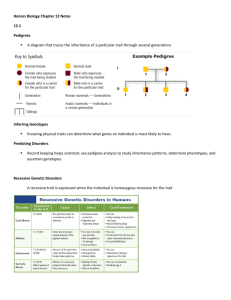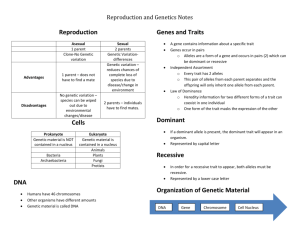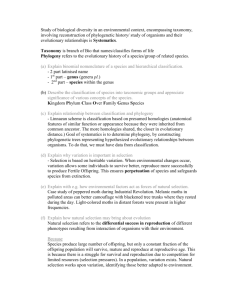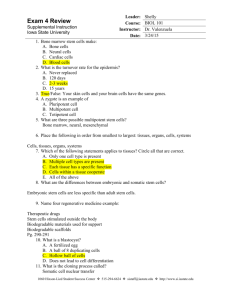Ms. Davies Notes for CRCT Review
advertisement
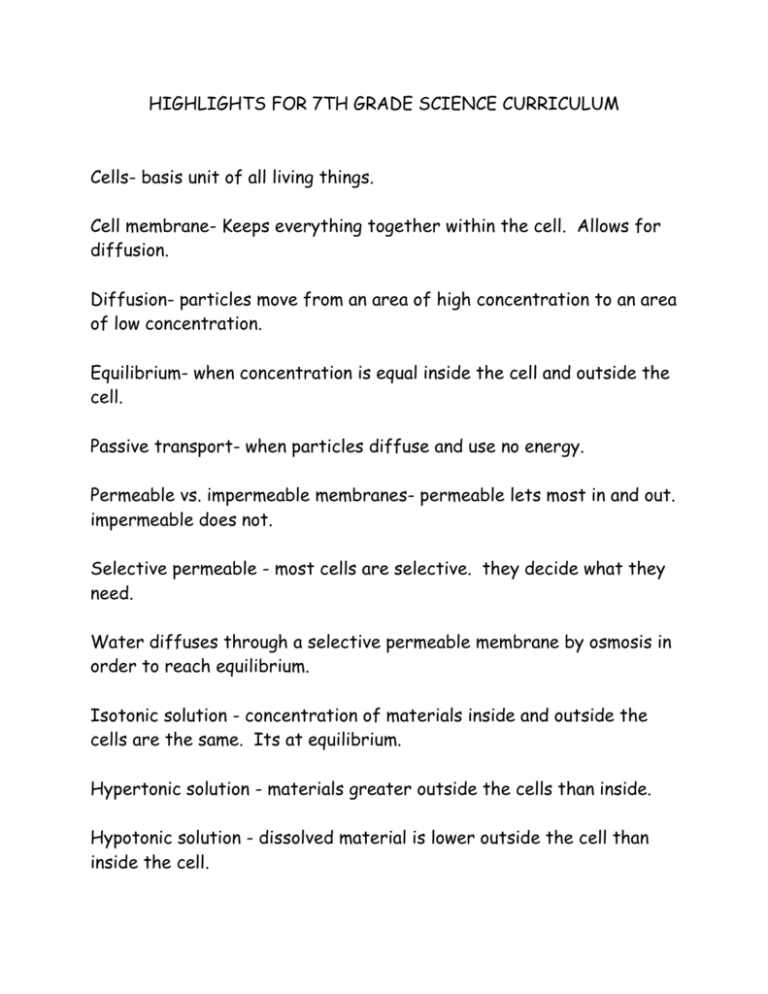
HIGHLIGHTS FOR 7TH GRADE SCIENCE CURRICULUM Cells- basis unit of all living things. Cell membrane- Keeps everything together within the cell. Allows for diffusion. Diffusion- particles move from an area of high concentration to an area of low concentration. Equilibrium- when concentration is equal inside the cell and outside the cell. Passive transport- when particles diffuse and use no energy. Permeable vs. impermeable membranes- permeable lets most in and out. impermeable does not. Selective permeable - most cells are selective. they decide what they need. Water diffuses through a selective permeable membrane by osmosis in order to reach equilibrium. Isotonic solution - concentration of materials inside and outside the cells are the same. Its at equilibrium. Hypertonic solution - materials greater outside the cells than inside. Hypotonic solution - dissolved material is lower outside the cell than inside the cell. Facilitated diffusion - diffusion of molecules through protein channels. Still diffusion, so still passive transport. Active transport- uses energy to move SMALL molecules or ions into areas where they are more concentrated (against equilibrium). Larger materials require a process called endocytosis. Cell membrane forms a fold/pocket called a vesicle around the particle. Then breaks off and allows materials through the membrane. Exocytosis removes materials in the same way. Endo - “in da door” Exo- “exit da door” Eukaryotic cells - eu carry it;) has organelles. Look at page 48 in CRCT book. differences in plants and animal cells. Both have: Nucleus- brain of the cell. Control center. Stores genetic information. Has a membrane, too! Cytoplasm - fluid that holds all organelles. Gel like fluid. Ribosomes- proteins are made/held here. Determine processes/traits of the cell. ER- endoplasmic reticulum. Moves materials from one place to another within the cell. Like a train. Two types - rough (carries ribosomes) and smooth. It regulates processes in the cells. Like muscles contractions or breaking down toxins in a liver. Golgi Apparatus- proteins from ER move to Golgi. Sorts and organizes the proteins in the cell. Lysosomes- act like a digestive system. Can digest compounds and old organelles. Mitochondria- convert chemical energy into compounds that can be used by the cell. Plants have 3 additional structures: 1- cell wall- rigid/stiff wall. for protection. contains cellulose. 2- chloroplasts- captures energy from the sunlight and converts it to chemical energy in the process known as photosynthesis. One pigment that helps capture sunlight is chlorophyll. It gives the plant its green color. 3- vacuole- store enzymes and wastes. toliet of the cell. makes cell rigid. when its flushed, plant becomes limp and wilty. Amoebas and paramecium consist of only one cell. Cell organization----------------->>>>> Cells make up tissues that make up organs that make up organ systems that make up an organism. cells-->tissues-->organs-->organ systems-->organism Many types of cells, Like: Red blood cells, white blood cells, and nerve cells. 4 basic types of tissues: muscles, nervous, connective, and epithelial (like skin, that protects structures beneath it) Organs like heart, lungs, livers and stomach Organ systems - Sir Nerd Clemi (skeletal, integumentary, respiration, nervous, endocrine, reproductive, digestive, circulatory, lymphatic, excretory, muscular, and immune. Photosynthesis6co2 +6h2o+light energy ---> c6h126o6+ 6o2 reactants products glucose Cellular respirationcells break down food molecules to release stored energy. Glucose is broken down and energy released. c6h1206+6o2---> 6co2+6h2o+energy ^ Photosynthesis and cellular respiration are complete opposites. There is a 3rd process: Fermentation- cells obtain energy with o2. cells use o2 too fast and fermentation of acids or alcohol is left. Like with muscles after strenuous activity. Major Organ systems - interact to provide cells with 02 and nutrients and to rid the cells of waste. Skeletal- bones, cartilage, ligaments and tendons. Muscular- movements and circulates blood and food. involuntary and voluntary. Integumentary- skin, hair and nails. first barrier against infections and helps regulate body temperatures. Nervous- controls and coordinates functions. Smell, touch, taste, sight and sound. Neurons are the cell structures. CNS and PNS. Endocrine- chemical messengers called hormones. growth, development and metabolism. Respiratory- provides 02 for cellular respiration. removes co2. In the lungs, gases are exchanged as well as blood with o2 and with co2. Circulatory- brings o2, nutrients, and hormones to cells and removes wastes, and regulates body temperature. Lymphatic- as blood travels through our bodies, fluids leek out. called lymph. returned to the circulatory system by the lymphatic system. lymph nodes filter out bacteria and diseases. Digestive- converts food into simple sugars. mechanical and chemical. Excretory- removes wastes through kidneys, skin, lungs. 2 wastes- urea and excess h2o. Reproductive- sperm and eggs. produces a zygote--->fetus (this is a result of cell division). Immune- protects from diseases. fights pathogens. Heredity- passing of physical traits from parents to offspring. Genetics- study of heredity. Gregor Mendel- father of genetics. did pea plants study. factors that control traits are called genes. different forms of a gene are called alleles. 2 alleles for each trait. one from each parent. 2 alleles can be same or different. if different, the dominant allele shows up and recessive gene is hidden. 2 recessive must be present for recessive trait to show up. 2 identical alleles is called purebred. hybrid- 2 different alleles for a trait. Genotype- combo of alleles. Phenotype- trait expressed. Punnett Square- diagram that shows all possible allele combinations. Capital letter is dominate lower case letter is recessive dominate always written first Humans have 23 pairs of chromosomes and 46 sets. Sexual Reproduction - 2 parents produce offspring. They produce sex cells. fertilization - sperm cell joins an egg cell. Sex cell has 23 chromosomes. when joined it is 46 chromosomes. Meoisis allows for random allele arrangements. Asexual reproduction - one parent produces offspring. identical to parent. Bacteria. Binary fission- copy of genetic material. cell divides into 2 cells. Budding - yeast do this form of reproduction. bud grows and breaks off. Bacteria can also reproduce sexually by conjugation. One bacteria transfers some genetic material to another. After transfer, the cell splits. Selective breeding- use genetic patterns that occur naturally to pass desired traits onto the next generation. Inbreeding - within a line of organisms to produce similiar characteristics. can cause genetic defects. hybridization- crosses individual with different traits. To try and get the best of both. Genetic engineering- removing genetic material and inserting it into another. Cloning- like Dolly the sheep. Genetic information from a single cell to replicate the exact same genetic information. Robert Hooke- cut thin slice of cork to see cells for the first time. Schledien- concluded that plants were made out of cells. Schwaan- concluded that animals were made out of cells. The two together concluded that all living things were made out of cells. Virchow- cells divide to make new cells. Together they all came up with cell theory- cells come from other cells.

